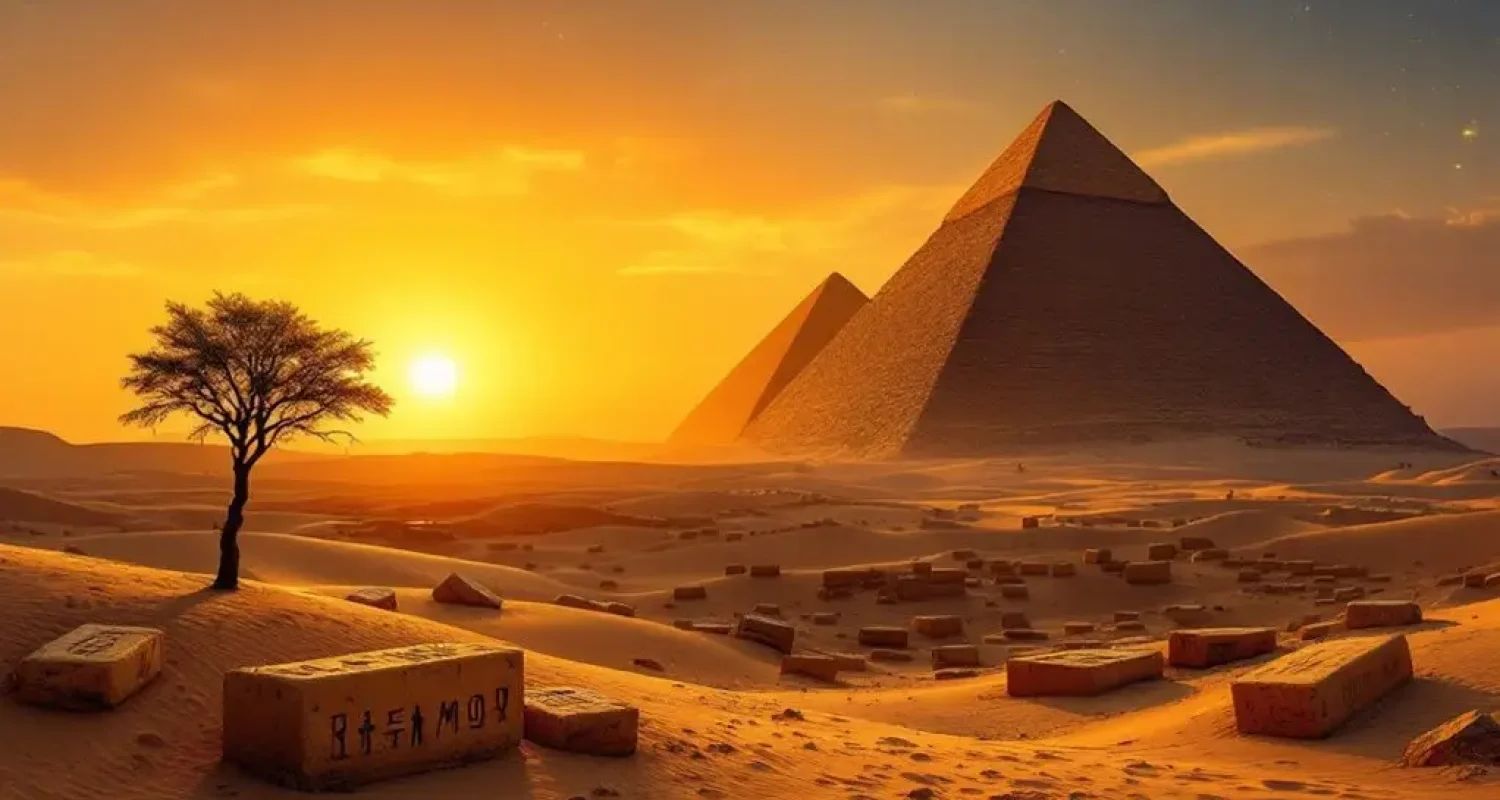When you think about Africa's historical landmarks, what comes to mind? You might picture the grandeur of the Pyramids or the intricate beauty of Lalibela's churches. This quiz challenges your knowledge of these sites while illuminating their cultural significance and the stories they tell. As you navigate through questions about architectural wonders and natural treasures, consider how these landmarks have shaped not just local cultures but the world at large. Are you ready to uncover the deeper connections between these sites and their impact on global heritage?
Key Takeaways
- The Pyramids of Giza, a UNESCO World Heritage Site, exemplify ancient Egyptian architectural brilliance and are one of the Seven Wonders of the Ancient World.
- The Great Mosque of Djenné is the largest mud-brick structure in the world, showcasing a blend of Islamic and local architectural traditions.
- Lalibela Churches in Ethiopia are rock-carved structures significant for pilgrimage, reflecting the country's rich religious heritage and architectural ingenuity.
- Victoria Falls, one of Africa's natural wonders, spans over 5,600 feet and is a key tourist attraction due to its breathtaking beauty.
- Historical sites like Timbuktu represent advanced civilizations and are vital for understanding Africa's cultural and intellectual heritage.
Overview of African Landmarks
Africa's landmarks are a vibrant tapestry of history, culture, and natural beauty, drawing millions of visitors each year. These African landmarks range from ancient structures to breathtaking natural wonders, each telling its own unique story.
For instance, the Pyramids of Giza, a UNESCO World Heritage Site, exemplify the continent's rich historical narrative while attracting historians and tourists alike. Meanwhile, natural wonders such as Victoria Falls and the Great Rift Valley captivate nature enthusiasts with their stunning vistas and ecological diversity.
Modern architecture, like the Great Mosque of Djenné, further enriches this tapestry, showcasing Africa's architectural heritage and the evolution of its cultural identity.
As you explore, you'll find that these landmarks aren't just beautiful; they play a vital role in local economies. The tourism they generate creates jobs and supports conservation efforts, ensuring that these sites remain preserved for future generations.
Whether you're hiking up Mount Kilimanjaro or marveling at Table Mountain, each experience deepens your appreciation for Africa's diverse landscapes and historical significance. In doing so, you become part of a larger narrative that celebrates the continent's enduring legacy.
Historical Significance of Sites
The historical significance of Africa's landmarks is deeply intertwined with the continent's legacy of advanced civilizations and cultural achievements. Many of these historical landmarks, like the Pyramids of Giza, date back thousands of years, serving as a reflection of the ingenuity and sophistication of the societies that built them.
UNESCO World Heritage Sites often include these landmarks, highlighting their global cultural importance and the urgent need for preservation.
Take Timbuktu, for instance. It's renowned not just for its breathtaking architecture but also for its historical manuscripts and mosques, which reflect the rich intellectual heritage of ancient African societies.
Similarly, the Valley of the Kings in Egypt, where the tomb of Tutankhamun rests, showcases elaborate burial customs and the deep spiritual beliefs surrounding the afterlife.
Preservation efforts for these sites are vital. They provide invaluable insights into past societies, their cultures, and their contributions to human history.
Without such efforts, the stories these historical landmarks tell could fade away, robbing future generations of an understanding of Africa's vibrant and diverse heritage.
Natural Wonders in Africa
When you explore Africa's natural wonders, you encounter breathtaking landscapes and rich biodiversity that are essential for conservation efforts.
Sites like Victoria Falls and Mount Kilimanjaro not only showcase nature's grandeur but also play an important role in tourism, greatly impacting local economies.
As you consider these iconic landmarks, you'll see how they intertwine with the continent's heritage and the ongoing commitment to protect these treasures.
Iconic Natural Landmarks
Exploring the iconic natural landmarks of Africa reveals a continent rich in breathtaking beauty and geological wonders. From towering mountains to lush valleys, each landmark tells a unique story.
If you're taking a quiz on these marvels, consider the following highlights:
- Victoria Falls: Spanning over 5,600 feet, this majestic waterfall is twice the size of Niagara Falls, enchanting visitors with its sheer power and beauty.
- Mount Kilimanjaro: Standing at 19,341 feet, it's Africa's highest peak, featuring three distinct volcanic cones: Mawenzi, Shira, and Kibo. Its diverse ecosystems attract climbers and nature enthusiasts alike.
- Sossusvlei: Known for its striking red sand dunes, with the tallest reaching 325 meters, this Namibian landscape is a photographer's paradise.
Each of these landmarks showcases Africa's geological diversity and natural splendor.
Additionally, the Great Rift Valley and Ngorongoro Crater highlight the continent's dynamic landscapes and rich biodiversity.
When you think of Africa's iconic landmarks, remember these natural wonders that not only define the continent's geography but also its heritage.
Biodiversity and Conservation Efforts
Biodiversity in Africa is a vibrant tapestry, woven from the continent's diverse ecosystems and species that thrive within them. Each landmark, like Victoria Falls and Mount Kilimanjaro, plays an essential role in supporting unique flora and fauna.
The Great Rift Valley stands out as a geological marvel, showcasing varied habitats that harbor many endemic species. Understanding these ecosystems is crucial, as they contribute to the continent's ecological richness.
One of the most striking examples of biodiversity is found in Serengeti National Park, where the annual migration of over 1.5 million wildebeest and countless zebras illustrates the delicate balance of life within the park. This migration isn't just a spectacle; it underscores the ecological significance of maintaining these habitats.
However, the threats posed by climate change and habitat loss necessitate robust conservation efforts. Initiatives aimed at protecting endangered species, particularly the African elephant, are important for sustaining ecological balance.
Tourism and Economic Impact
Africa's natural wonders, like Victoria Falls and Mount Kilimanjaro, not only showcase the continent's breathtaking landscapes but also play a vital role in driving tourism and economic growth.
These iconic sites attract millions of visitors each year, greatly boosting local economies. The impact of tourism on these regions is profound:
- Tourism supports over 1 million jobs, promoting community development.
- Visitor spending on wildlife safaris and guided tours contributes billions to African GDP annually.
- Infrastructure developments, including roads and hotels, enhance access and create economic opportunities.
Sustainable tourism practices around these natural wonders are essential. They not only foster economic development but also promote conservation efforts, ensuring that unique ecosystems and biodiversity are protected for future generations.
By investing in sustainable tourism, you're not just experiencing Africa's beauty; you're also contributing to the preservation of its invaluable resources.
As you explore these landmarks, remember that your choices can have lasting effects. Supporting local businesses and engaging in eco-friendly activities helps maintain the balance between tourism and environmental preservation.
With your involvement, the economic benefits of tourism can continue to flourish, enriching both the land and its people.
Architectural Marvels to Explore
Embrace the rich tapestry of architectural wonders that showcase Africa's heritage, where each structure tells a story of its time and culture. Among these architectural marvels, the Great Sphinx of Giza stands out, with its enigmatic likeness of a pharaoh and a lion, dating back to around 2500 BC. It embodies the ingenuity and artistry of ancient Egyptians.
In Morocco, the Hassan II Mosque, completed in 1993, soars with the world's tallest minaret at 210 meters. Perched over the Atlantic Ocean, it reflects modern Islamic architectural brilliance while paying homage to traditional designs.
Traveling south, the Castle of Good Hope in South Africa reveals the colonial past, as the oldest surviving structure built in the 17th century, showcasing Dutch influences in its design.
Meanwhile, the Aksum Obelisks in Ethiopia, towering at 24 meters, symbolize the ancient Kingdom of Aksum's greatness, carved from solid granite.
Lastly, the Great Mosque of Djenné in Mali, the largest mud-brick structure globally, captivates with its unique Sudano-Sahelian style, earning its status as a UNESCO World Heritage Site.
Each of these marvels invites exploration and understanding of Africa's diverse architectural legacy.
Cultural Heritage and Traditions
When you explore Africa's cultural heritage, you'll find that it's woven into every aspect of life, from traditional ceremonies to vibrant arts and crafts.
Celebrations like Kuomboka and Ncwala not only mark seasonal changes but also serve as essential touchstones for preserving the rich tapestry of ethnic identities.
Understanding the importance of these practices and the preservation of historical sites helps you appreciate the depth and resilience of Africa's diverse cultures.
Importance of Cultural Heritage
Preserving cultural heritage plays an indispensable role in shaping community identity and fostering a sense of belonging. It encompasses the traditions, customs, and artifacts passed down through generations, reflecting the unique history of each community.
In Africa, with over 3,000 languages spoken, this rich diversity showcases the vibrant tapestry of cultural expressions that unite people.
The importance of cultural heritage can be summarized as follows:
- It maintains diversity, serving as a reminder of the different ways communities have thrived.
- It fosters community pride, allowing individuals to connect with their roots and share their stories.
- It guarantees continuity in an ever-changing world, providing stability amidst globalization.
UNESCO recognizes numerous African sites as World Heritage Sites, emphasizing their global significance, such as the Rock-Hewn Churches of Lalibela in Ethiopia.
Traditional ceremonies, like Zambia's Kuomboka, exemplify how cultural heritage celebrates identity and strengthens community bonds. Through colorful attire, music, and dance, these practices create lasting memories and reinforce ties among community members.
Ultimately, cultural heritage is vital not just for the past, but also as a powerful foundation for the future, guaranteeing that the essence of diverse identities continues to thrive.
Traditional Practices and Celebrations
Across the diverse landscapes of Africa, traditional practices and celebrations offer a vivid glimpse into the continent's rich cultural fabric. Each of Africa's over 70 ethnic groups maintains unique customs, rituals, and beliefs that reflect their identity and heritage.
For instance, the Kuomboka ceremony in Zambia marks the Lozi king's annual migration, while the Ncwala festival among the Ngoni celebrates the first fruits of the harvest. These events not only connect communities but also reinforce the values and stories that have shaped their existence.
Arts and crafts are integral to these traditional practices, with skills like basket weaving, beadwork, and wood carving passed down through generations. Local festivals often showcase these crafts, highlighting the creativity within each culture.
Additionally, music and dance play an essential role in celebrations, where traditional rhythms and movements convey stories and connect people to their ancestors.
Moreover, many African communities emphasize the preservation of their languages and oral histories. By prioritizing storytelling, they maintain a living link to their past, ensuring that traditional practices remain vibrant and relevant in contemporary life.
Ultimately, traditional practices and celebrations serve as a reflection of Africa's diverse and enduring cultural legacy.
Preservation of Historical Sites
Traditional practices and celebrations not only reflect the vibrancy of African cultures but also underscore the importance of preserving historical sites that embody these legacies. The preservation of these landmarks is essential for maintaining cultural heritage and identity. UNESCO has recognized over 130 sites as World Heritage Sites, emphasizing their global significance.
To effectively safeguard these treasures, various strategies are employed, including:
- Community engagement to foster local stewardship
- Educational programs that provide context and highlight significance
- Innovative solutions to combat challenges like funding and climate change
These efforts face obstacles, such as political instability and limited resources, but the role of local traditions remains critical.
Storytelling and cultural festivals promote awareness, ensuring that these sites continue to resonate with both locals and visitors. By participating in educational initiatives, you can gain a deeper understanding of how these historical sites shape African identity and history.
Ultimately, the preservation of historical landmarks isn't just about maintaining structures; it's about honoring the stories and traditions they represent, forging connections between the past and present, and nurturing a cultural legacy for future generations.
Tourism Impact on Economies
Tourism at historical landmarks in Africa has a profound impact on local economies, especially in regions rich in cultural heritage. The influx of visitors not only generates significant revenue but also supports various sectors. For instance, Zambia's Victoria Falls draws over 1 million tourists annually, enhancing the local GDP. In 2019, tourism accounted for 8.6% of Africa's GDP, emphasizing the crucial role of historical sites in economic development.
Here's a closer look at how tourism influences local economies:
| Sector | Economic Impact | Examples |
|---|---|---|
| Hospitality | Job creation and income generation | Hotels, restaurants |
| Transportation | Increased demand for services | Taxis, tour operators |
| Cultural Heritage | Promotion of local crafts | Artisanal markets |
| Guided Tours | Enhanced visitor engagement | Local guides |
| Food Services | Showcase of cultural cuisine | Traditional restaurants |
Local communities thrive through tourism-related activities, such as guided tours and artisanal crafts. When sustainable tourism practices are prioritized, they not only improve visitor experiences but also guarantee the long-term conservation of these landmarks, securing ongoing economic benefits for future generations.
Conservation Efforts for Landmarks
The economic benefits generated by tourism at historical landmarks underscore the importance of conservation efforts aimed at preserving these sites for future generations. Organizations like UNESCO and local governments collaborate to implement effective preservation strategies that guarantee the historical integrity and cultural significance of endangered landmarks.
Community engagement plays a crucial role in restoration projects, allowing local populations to participate actively in safeguarding their heritage. This involvement fosters a sense of pride and ownership among residents.
Consider these key aspects of conservation efforts:
- Environmental policies address threats from climate change, urbanization, and pollution.
- Funding sources combine government grants, international aid, and tourism revenue, highlighting the economic significance of maintaining these sites.
- Education programs raise awareness about the importance of landmarks, encouraging both locals and tourists to contribute to preservation efforts.
Ultimately, the successful conservation of historical landmarks relies on a multifaceted approach. By combining community involvement, sustainable funding, and educational initiatives, we not only protect these sites but also enhance their potential as economic and cultural assets for the future.
Iconic Landmarks by Country
Across Africa, you'll find a rich tapestry of iconic landmarks that tell the diverse stories of the continent's history and culture. Each landmark reflects the unique heritage of its country, showcasing the architectural brilliance and natural wonders that define Africa.
Here's a look at some of these remarkable sites:
| Country | Landmark |
|---|---|
| Egypt | Pyramids of Giza |
| South Africa | Table Mountain |
| Morocco | Hassan II Mosque |
| Ethiopia | Lalibela Churches |
| Tanzania | Mount Kilimanjaro |
The Pyramids of Giza, among the Seven Wonders of the Ancient World, stand as a representation of ancient Egyptian civilization's architectural prowess. In South Africa, Table Mountain offers breathtaking views, attracting hikers and tourists keen to experience its natural beauty. Meanwhile, Morocco's Hassan II Mosque impresses with its intricate design and towering minaret.
Ethiopia's Lalibela Churches, carved from rock, serve as a pilgrimage site for many. Finally, Mount Kilimanjaro beckons adventure enthusiasts to conquer its heights, showcasing the African spirit of exploration. Each landmark invites you to engage with Africa's rich cultural narrative.
Festivals Celebrating Heritage
Festivals celebrating African heritage serve as vibrant showcases of culture, uniting communities and preserving traditions through music, dance, and culinary delights.
These events not only honor ancestral practices but also provide platforms for artists and performers to express their cultural identities.
Consider a few notable examples:
- The Harare International Festival of the Arts in Zimbabwe draws talent from across the continent, highlighting the diversity of African artistry.
- Zambia's Ncwala Ceremony pays tribute to the Ngoni people's spirits, featuring traditional rituals that connect generations.
- The Fes Festival of World Sacred Music in Morocco promotes dialogue through spiritual music, illustrating the depth of African heritage.
These festivals are more than just celebrations; they're vital for fostering community pride and ensuring the continuity of cultural narratives.
Each event tells a story, weaving together the past and present, allowing participants to engage with their roots.
As you explore these festivals, you'll discover how they encapsulate the richness of African traditions, inviting both locals and tourists to partake in a shared cultural experience.
Ultimately, festivals celebrating African heritage play an important role in preserving the continent's diverse identities.
Frequently Asked Questions
How Can I Participate in the Quiz on African Heritage?
To participate in the quiz on African heritage, you'll want to explore its cultural significance first. Understanding the historical context will enhance your experience and enjoyment.
Look for online platforms or local events that host such quizzes. Once you find one, register and prepare by studying key landmarks and their stories.
Engaging with the material won't only improve your chances of success but deepen your appreciation for the rich heritage you're exploring.
Are There Prizes for Completing the Quiz?
Did you know that engaging in quizzes can boost your knowledge retention by up to 50%?
When it comes to participating in this quiz, you might be curious about prize incentives. Yes, there are rewards for completing the quiz!
These incentives not only motivate you to dive deeper into the material but also enhance your learning experience.
What Age Group Is the Quiz Designed For?
The quiz is designed to engage a diverse target audience, typically ranging from teenagers to adults.
It's crafted to cater to those who've a keen interest in history and heritage.
You'll find that the content is accessible yet challenging, encouraging participants to expand their knowledge.
Can I Access the Quiz Online or in Person?
You won't believe the wonders of quiz accessibility! You can immerse yourself in this quiz online, releasing your inner history buff without ever leaving your couch.
It's like having a treasure chest of knowledge at your fingertips! If you're craving a more tactile experience, check if local venues offer it in person.
Whichever way you choose, you're sure to start an enlightening journey through fascinating historical landmarks. Get ready to explore!
How Often Is the Quiz Updated With New Questions?
You might wonder about the question frequency for the quiz. Typically, quizzes like this get updated regularly to guarantee they remain relevant and engaging.
You can expect new questions to be added periodically, often reflecting current events or recent discoveries. This approach keeps the content fresh and encourages you to deepen your understanding.
Conclusion
As you've journeyed through Africa's historical landmarks, you've uncovered the vibrant threads woven into the continent's rich tapestry. Each site tells a story, echoing the resilience and creativity of its people. By appreciating these treasures, you not only honor their past but also contribute to their future. Just like a river carving its path through stone, your curiosity can shape a deeper understanding of Africa's cultural heritage, ensuring it flows into generations yet to come.








